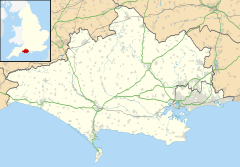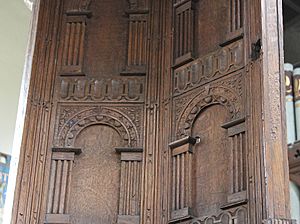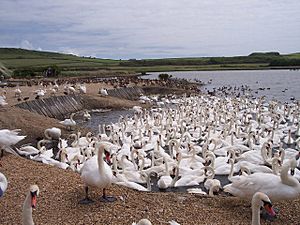Abbotsbury facts for kids
Quick facts for kids Abbotsbury |
|
|---|---|
 Rodden Row, Abbotsbury |
|
| Population | 451 |
| OS grid reference | SY576853 |
| • London | 139 miles (224 km) |
| Civil parish |
|
| Unitary authority |
|
| Shire county | |
| Region | |
| Country | England |
| Sovereign state | United Kingdom |
| Post town | WEYMOUTH |
| Postcode district | DT3 |
| Dialling code | 01305 |
| Police | Dorset |
| Fire | Dorset |
| Ambulance | South Western |
| EU Parliament | South West England |
| UK Parliament |
|
| Website | http://www.abbotsbury.co.uk/ |
Abbotsbury is a charming village and civil parish in the English county of Dorset. It's located about 12 kilometers (7.5 miles) west-southwest of Dorchester. The village is also just 1.6 kilometers (1 mile) inland from the English Channel coast. In 2021, the village and its surrounding area had a population of 451 people.
Abbotsbury is a very popular spot for tourists. It's famous for its beautiful old buildings and cottages with thatched roofs. The village offers many fun attractions and is a great starting point to explore the Jurassic Coast World Heritage Site. It's also part of the stunning Dorset National Landscape. Some of its most well-known places include the swannery, the subtropical gardens, and parts of the old Abbotsbury Abbey. This includes St Catherine's Chapel, a 14th-century chapel on a hill overlooking the sea. The coastline nearby features a section of Chesil Beach. Plus, two long walking paths, the South West Coast Path and Macmillan Way, go right through the village.
A large part of the village, including the swannery and gardens, is owned by the Ilchester Estate. This estate owns about 6,000 hectares (15,000 acres) of land in Dorset.
Contents
Exploring Abbotsbury's Location
Abbotsbury village is in the Dorset administrative area. It sits about 1.6 kilometers (1 mile) from the English Channel coast. Here you'll find Chesil Beach, a long 29-kilometer (18-mile) barrier beach. South of the village, Chesil Beach creates The Fleet, a coastal lagoon with slightly salty water. To the north, the Dorset Downs, which are rolling chalk hills, rise steeply.
The village is about 11 kilometers (7 miles) northwest of Weymouth and 13 kilometers (8 miles) southeast of Bridport. The main road through Abbotsbury is the B3157, which connects it to these towns. Abbotsbury is also about 10 kilometers (6 miles) from Upwey railway station. The coastline in Abbotsbury parish is part of the Jurassic Coast, a famous World Heritage Site. The entire parish is also within the Dorset Area of Outstanding Natural Beauty, which means it's a specially protected landscape.
A Look Back at Abbotsbury's Past
Ancient Times and the Abbey
About 2.4 kilometers (1.5 miles) northwest of the village, on top of Wears Hill, you can see the remains of Abbotsbury Castle. This was an Iron Age hill fort, a type of ancient defensive settlement. The earthworks cover an area of about 4 hectares (10 acres).
In the 10th century, a document from King Edmund mentions land at Abbedesburi. This name suggests the land might have once belonged to an abbot. Later, in the 11th century, King Cnut gave land nearby to a Scandinavian noble named Orc. He and his wife Tola founded Abbotsbury Abbey and gave it a lot of land.
In 1086, the Domesday Book recorded Abbotsbury as Abedesberie or Abodesberie. It had 62 households and two mills. The abbey was very important for 500 years. However, it was destroyed during the Dissolution of the Monasteries, a time when monasteries in England were closed down. Luckily, the abbey barn survived. Stone from the destroyed abbey was used to build many other buildings in the village.
Civil War and Fires
In 1644, during the English Civil War, soldiers from both sides fought in Abbotsbury. Parliamentarian soldiers surrounded the Royalists in St. Nicholas' church. You can still see two bullet holes from this fight in the church's old pulpit. The Strangways house, which was built where the abbey used to be, was also attacked and burned down. This fire also destroyed old abbey records that were stored there.
In the late 1600s and early 1700s, Abbotsbury suffered several fires. These fires destroyed almost all of the village's medieval buildings. This is why most of the old stone houses you see today were built in the 17th and 18th centuries.
Village Life and Growth
An old historian named John Hutchins wrote that fishing was the main job in the village. Farming was also very important. Other jobs included making ropes, baskets, and cotton stockings. People grew hemp and withies (willow branches) in the area for these crafts.
In the early 1800s, Abbotsbury's population grew steadily. It went from about 800 people in 1801 to nearly 1,100 sixty years later.
World War II
During Second World War, the coast near Abbotsbury was made stronger to defend against invasion. The Fleet Lagoon was used for machine gun training. Even the famous "bouncing bombs" used in the "Dambuster" raid were tested there.
Today, Abbotsbury still has a long street of stone houses. Many of them have traditional thatched roofs, and some date back to the 16th century. The street widens in one spot, which used to be the old market square. The village is surrounded by hills on all sides except to the east. People have described Abbotsbury as a very pleasant place, and one writer called it "possibly the most interesting in Dorset."
There's also a small Royal Observer Corps Bunker near Abbotsbury Hill. It was used from 1959 to 1968 and is still mostly in one piece.
How Abbotsbury is Governed
Abbotsbury is part of the West Dorset parliamentary constituency for the national parliament.
For local government, Abbotsbury is in the Dorset unitary authority area. This is the highest level of local government. At the lowest level, it's part of the Chesil Bank civil parish. This parish also includes nearby villages like Portesham and Fleet. Abbotsbury elects four of the 15 councillors on the Chesil Bank Parish Council.
People from Abbotsbury
Some famous people have connections to Abbotsbury:
- Scientist James Lovelock, known for his Gaia hypothesis, lived in Abbotsbury later in his life.
- Judge Sir David Neuberger chose "Baron Neuberger of Abbotsbury" as his title when he became a Life Peer in 2007.
Getting Around Abbotsbury
The B3157 road, also known as "the coast road," runs between Abbotsbury and Burton Bradstock. This road is famous for its beautiful coastal views and is often suggested as a scenic route for tourists. West of the village, the road goes up Abbotsbury Hill. This is a 200-meter (656-foot) climb with a steep slope, making it a popular challenge for cyclists.
Abbotsbury has bus services called X52 (in summer) and X53. These buses connect the village to towns like Axminster, Lyme Regis, Bridport, Weymouth, Lulworth Cove, and Wool.
From 1885 to 1952, Abbotsbury had its own railway line, the Abbotsbury Railway. It was mainly used for carrying goods, like stone and iron ore. The station was built a bit outside the village center because the railway couldn't buy land closer in.
Important Buildings in Abbotsbury
Almost a hundred buildings in Abbotsbury are listed by English Heritage. This means they are important for their history or architecture. Six of these are listed as Grade I, which is the highest level of importance.
St Catherine's Chapel
South of the village, on a bare hill about 80 meters (262 feet) high, stands St Catherine's Chapel. This small chapel from the 14th century was used by the abbey monks for private prayer. It's built completely of stone, even the roof and ceiling! The walls are 1.2 meters (4 feet) thick and have strong supports called buttresses. The chapel looks out over the English Channel and might have been a beacon, like a lighthouse, for sailors. It is listed as Grade I.
St Nicholas' Church
The Parish Church of St Nicholas dates back to the 14th century. However, it has been changed and updated many times over the years. The church tower has three bells from 1773. The front part of the church, called the chancel, was updated in the 18th century and still has its plastered barrel roof and a beautiful altarpiece. You can also see some stained glass from the 15th century, a stone statue of one of the abbots, and an old pulpit. The church is listed as Grade I.
Abbotsbury Abbey Tithe Barn
The Abbotsbury Abbey tithe barn was built around 1400. It's huge, measuring 83 by 9.5 meters (272 by 31 feet)! It's known as the world's largest thatched tithe barn. A tithe barn was used to store a portion of crops given to the church. Part of the barn's roof has been missing since the 17th century, but the remaining 12 sections are covered with thatch. This barn is also listed as Grade I.
The Ilchester Estate and Its Attractions
The Ilchester Estate owns about 6,000 hectares (15,000 acres) of land in Dorset, including Chesil Beach and Abbotsbury. It's currently owned by Mrs Charlotte Townshend.
Abbotsbury Swannery
Located south of the village on the edge of the Fleet lagoon, Abbotsbury Swannery is over 600 years old. It was once owned by the abbot and used to provide meat for the abbey. Today, it's a large home for mute swans and other water birds. It's open to the public. The swannery is a very important place for swans to nest and breed. From May through the summer, you can see baby swans, called cygnets, up close.
Abbotsbury Subtropical Gardens
The Abbotsbury Subtropical Gardens were started in 1765 by the Countess of Ilchester. They began as a kitchen garden for the nearby castle. Since then, the gardens have grown into an 81,000 square meter (20-acre) site filled with amazing plants from all over the world. Many of these plants were new discoveries when they were first brought here. You can find both formal and informal gardens, with lovely woodland walks and walled gardens. In 1990, strong storms damaged many of the rare plants, but they have since been replaced with younger ones.
Village Life and Fun Things to Do
Abbotsbury has a village hall called the Strangways Village Hall. It's run by a charity and can be rented for events. The village also has two public houses, The Ilchester Arms and The Swan Inn. You'll find several tearooms, small shops, and other businesses. There's also a cricket ground for sports fans.
Abbotsbury Garland Day
Abbotsbury Garland Day is a special tradition held every year on May 13th. It has been celebrated since the early 1800s. The custom was first written about in 1867. Originally, children of local fishermen would make garlands (flower wreaths). These garlands were blessed in a church service. Some were then taken out to sea in boats and tossed into the water. The children would then spend the rest of the day playing on the beach.
After World War I, the tradition changed a bit. Children who weren't from fishing families started to join in, probably because the local fishing industry was getting smaller. The village school used to give the children a day off. They would make two garlands: one from wild flowers and one from garden flowers. They would carry these garlands on poles from house to house in the village. Their goal was to collect money, which the children would keep. Later in the day, older children who went to school in Weymouth would come home and make a more detailed garland. This one would also be taken around the houses. Two garlands would also be placed on the war memorial.
The Abbotsbury village school closed in 1981. So, children no longer get a holiday for Garland Day. Now, the celebrations usually happen in the evening or on the nearest Saturday.









